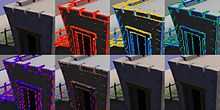Fast approximate anti-aliasing

Comparison between (from left to right)Without anti-aliasing, 4x MSAA, and FXAA.
Fast Approximate Anti-Aliasing (FXAA) is an anti-aliasing algorithm created by Timothy Lottes under NVIDIA.[1]
Advantages
- Does not require large amounts of computing power, achieved by smoothing jagged edges ("jaggies")[2] according to how they appear on screen as pixels, rather than analyzing the 3D models itself as in conventional anti-aliasing.[1]
- Smooths edges in all pixels on the screen, including those inside alpha-blended textures and those resulting from pixel shader effects, which were previously immune to the effects of multisample anti-aliasing (MSAA).[3]
Basically the simplest and easiest thing to integrate and use.
Timothy Lottes[4]
Disadvantages
- Textures may not appear as sharp if they are included in the edge detection.
- Must be applied before rendering the HUD elements of the game, lest it affect them too.
Processes

FXAA processing illustrations
The processes of FXAA are listed as follows:
- Find all edges contained in the image.
Finding edges is typically a depth-aware search, so that pixels which are close in depth are not affected. This helps to reduce blurring in textures, since edges in a texture have similar depths.
- Smooth the edges.
Smoothing is applied as a per-pixel effect. That is, there is no explicit representation of the edges. Rather, the first step is a depth-aware edge filter, which marks pixels as belonging to edges, and the second step filters the color image values based on the degree to which a pixel is marked as an edge.
References
- ↑ 1.0 1.1 Lottes, Timothy (February 2009). "FXAA". NVIDIA. Retrieved 29 September 2012.
- ↑ Wang, James (March 19, 2012). "FXAA: Anti-Aliasing at Warp Speed". NVIDIA. Retrieved January 3, 2013.
- ↑ Atwood, Jeff (December 7, 2011). "Fast Approximate Anti-Aliasing (FXAA)". Coding Horror. Retrieved September 30, 2012.
- ↑ Lottes, Timothy (September 3, 2011). "NVIDIA FXAA". Retrieved September 30, 2012.